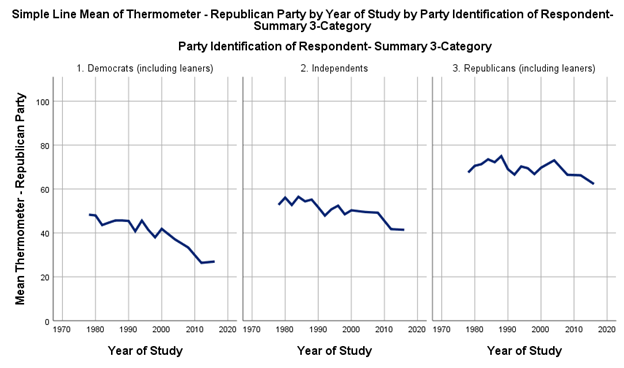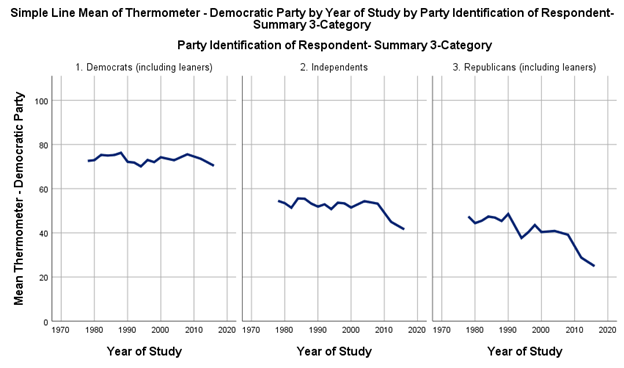
PART 3 – HOW TO CHANGE MINDS USING DIGITAL MEDIA? PERSUASION
We have finally arrived at part 3 of 3 on the topic of “How to Change Minds Using Digital Media? Persuasion.”
In Part 1 – we explored the formation of beliefs, values, and opinions.
Finally, in part 3 we explore what it takes to actually persuade.
But first it is recap time:
- Changing minds is extremely difficult.
- Many competing forces are at work to form and shape beliefs. These shift over time in importance and credibility.
- Many competing forces are at work and have an interest – normally economic – in sustaining your beliefs.
- Human brains are wired not to see things clearly, but to conserve energy and help us survive. We are all subject to two tiered thinking (think rider and elephant), with most of our thinking on autopilot.
- In politics, most people are on autopilot. They aren’t motivate enough or don’t care enough to think deeply about politics, and this is the power of party ID. If in general, I believe I share the same beliefs and values – I will look to cues mostly from party leaders and actual opinions become fungible.
This is why it is so difficult to change minds in politics. Politics creates feedback loops that activate beliefs, values. They create identities – “I am a Republican.” These identities are reinforced – hardening positions.
Cognitive Dissonance
Once positions are hardened then the concept of cognitive dissonance comes into play.
When people are faced with dis-confirming information, they become stressed. For the most part, people want their values, beliefs, opinions and behavior to be in agreement and alignment.
When faced with new information that dis-confirms a current mental model/reality, a person has a couple of choices
-
Denial – just ignore it
-
Bolstering – add thoughts to our side of argument
-
Differentiation – split arguments (i like the person, but disagree)
-
Integration – both can peacefully exist
In most cases, most will rationalize away the dis-confirming information.
We humans must construct a reality in line with our mental model / reality.
Yet, we do see people change their minds. So, we know it is possible. After all, we have seen massive changes in public opinion on the legalization of marijuana, on gay rights, on Russia.
Therefore, it is time the ask one of the best questions ever taught in grad school : when faced with two seemingly contradictory findings, ask under what conditions can BOTH be true?
Under what conditions even though difficult do people change their minds? How does digital media affect this process?
Persuasion, manipulation, and coercion
A quick note, in politics a lot of the time, when politicians, leaders, etc say they want to persuade, really they mean they want to use power to make you do something – they want to coerce you. They want to remove the choice and free will. “Do it or else….”
That is not what I am writing about – that is another blog post.

How to change minds
We must return to our rider and elephant metaphor of the dual processing in a person’s brain.
Most of the time, we are in elephant mode – lumbering through life, conserving energy, and confirming our beliefs.
In addition, we have seen that brute force attempts often boomerang and backfire.
If a person is unmotivated to change, we are likely to change beliefs, attitudes, or behaviors. Yes with coercion, we may be able to change short term behaviors, but it is unlikely to stick.
My model is my teenage son. I have come coercion at my disposal in the form of punishments, but if I want to affect true change – the seemingly only way is to allow him to think any and all change is 100 percent his idea. If I come directly at him and challenge him head on, he is sure to buck and dig in. My role as a caring and loving parent is to interrupt his lumbering elephant and shape the path. Real change is difficult, time consuming, indirect, and uncertain to work.
Step 1 – Interrupt the Elephant
We must interrupt the automatic thinking.
As we have discussed, often it is an event outside our control that opens people up to change. (9/11, trauma, job loss, etc.) At those times, we must “be willing to never waste a crisis.” Yes, there are true crisis, but the big stressors in life also open windows – new job, a death, moving. In these cases, move fast.
But how do we create our own momentum towards change? There is significant research into affective decision making and the roles of fear and anxiety. Yes, fear is a driver, but it appears to be more short term in nature. Anxiety is more insidious.
This is why so many digital headlines, ‘news’ stories, political stories are anxiety laden. Anxiety is the Trojan horse of persuasion.
Step 1 is to get interrupt the elephant, allow the thinking to move from automatic to deliberate, and allow the rider to take control.
A successful interruption will often embrace a novel, shocking, or provoking use of emotion, typically inducing anxiety.
We then need to work on shaping the path.
Considerations of the Interruption
What are we really trying to change? Beliefs, Attitudes, Opinions and/or behavior? This far too often is overlooked. Beliefs and Attitudes are difficult, but normally, we are attempting to work on short term behavior or opinions.
We must consider the starting point of target. How strongly held are their beliefs, attitudes, opinions and/or behaviors? Sometimes it is helpful to think of a football field. 50 yard line is neutral, and the goal lines are our strongest held beliefs. It is very rare that someone wholesale changes their beliefs…rather it is a process. They have to move the entire football field, and that takes time, effort and consistency. There are ‘zones of acceptance’ and if we are asking too large of a jump, we are looking at the success rate of a hail-mary. The zone of acceptance often forms the credibility of the message itself.
In addition, we must consider credibility. Someone outside our tribe, we are likely not to trust them or find them credible. In our efforts to ease our cognitive dissonance, if we can write off dis-confirming information as coming from a non-credible source, we can quickly return control to the elephant.
Finally, efficacy. The target must always feel like they are in control and not being manipulated or forced. “Do your own research….” “We are just asking questions…..” The need for efficacy is a powerful driver.
The Power of Questions
A good way to interrupt is a question. Allowing the target to answer the question. “How” questions are effective. No better political question than “how so?”
Shaping the Path
Once we have interrupted, the messenger must be credible, we need to frame information as being consistent with currently held beliefs, we need to show social proof (peer pressure), best to be an authority figure, and don’t forget the fear of loss / loss aversion.
Human behavior is greatly affected by the behavior of others – especially by people we like and trust. If we aren’t that into a subject, we will readily adopt the opinions and behaviors of our pastors, political leaders, friends, and co-workers. If a person sees someone in their tribe also making the change, we are apt to continue to think about it. It is why the entire ‘influencer’ markets exist. We must make great efforts to demonstrate social proof.
Unfortunately, many in the digital space make herculean efforts to manufacture fake social proof – it is also why false reviews are a massive, fake accounts are a massive problem, and bot nets exist. They are problems because they are highly effective tactics. There is significant research that volume can make up for low credibility. If we see a message from many different sources, the credibility can be lower – due to social proof.
If possible, create experiences for the target. The old adage of show, don’t tell. If trying to convince a political leader, arrange a personal tour. If tying to use digital media, use a virtual tour or a video to tell your story. Visuals are critical.
Consider inoculation. If you know the arguments against your position, best to bring them up and put them on the table. There is some research that shows the goal isn’t to REFUTE the arguments, but rather to simply acknowledge them. Chris Voss labels this an accusation audit. Regardless of what you label it, we have found it to be extremely effective.
Finally, take advantage of loss aversion. Humans fear loss. There is research showing that humans feel loss or the fear of loss 1.5 – 2 times than we value gain. At times in marketing, this is referred to as scarcity. (This offer expires in 10 minutes….). If you can massage your message to pique a loss frame, you will likely see an uptick.
An example – the vaccine whisperer
Adam Grant in his book Think Again provides the example of a local doctor who is called the vaccine whisperer. (Doctor = high credibility). When faced with a vaccine hesitant person, he doesn’t try to argue, get political, preach or make them a villain. He interviews. His goal is to get the person to see new possibilities.
The doctor tells the person they are concerned of what would happen if they became sick, but he accepted their decision but wanted to understand it better. (triggers anxiety, zone of acceptance). In the end, the doctor – after listening – would acknowledge the world is full of conflicting information, and reminded the patient “that they were free to choose and that he trusted their ability and intentions.” (inoculation, efficacy, non threatening).
The premises of this entire series is that we can’t make someone change. If we could, my teenagers would behave differently. We are better off coaching and helping them think everything is their idea by shaping the path of the elephant and rider.
The question for us in the digital space is how do we convert this one-on-one experience and convert it to the digital space?
Summary
One must understand to attempt to change minds is difficult and fraught with peril. We see this so much in today’s politics – what fails to persuade us, normally makes our beliefs stronger.
So, in most cases it is best to be first. Get there before positions are hardened. In digital advocacy, first mover has a large advantage.
Interrupt the elephant.
- Best done with emotion, not facts or stats.
- Anxiety inducing has been shown to lead the pack of emotions.
- Must be from a messenger target finds credible – a person of authority is typically best.
- Questions are helpful.
- Prompt or stimulus – Can be novel or shocking.
- Take advantage of events outside of your control.
Shape the Path.
- Framing new information in direction with targets’ beliefs and values is best. Pay attention to the zone of acceptance so that the message itself has credibility.
- Stress Efficacy. The target must feel in control. If they feel manipulated or coerced, they are likely to dig in and double down.
- Show (don’t tell) how people like them are / have made the change you want. Create Experiences.
- Use as many and as various of validators or endorsers as you can muster.
- Consider the technique of inoculation.
Additional Reading
- Cialdini, Robert B. Influence, New and Expanded : the Psychology of Persuasion . First Harper Business new and expanded hardcover edition. New York: Harper Business, an imprint of HarperCollins Publishers, 2021. Print.
- Grant, Adam. Think Again : the Power of Knowing What You Don’t Know . New York, New York: Viking, an imprint of Penguin Random House LLC, 2021. Print.
- Haidt, Jonathan. The Happiness Hypothesis : Finding Modern Truth in Ancient Wisdom . New York: Basic Books, 2006. Print.
- Joseph Grenny et al. Influencer: The New Science of Leading Change, Second Edition, 2nd Edition. McGraw-Hill, 2013. Print.
- Kahneman, Daniel. Thinking, Fast and Slow . 1st ed. New York: Farrar, Straus and Giroux, 2011. Print.
- Lakoff, George. The All New Don’t Think of an Elephant: Know Your Values and Frame the Debate. White River Junction: Chelsea Green Publishing, 2014. Print.
- Marcus, George E., W. Russell. Neuman, and Michael. MacKuen. Affective Intelligence and Political Judgment . Chicago: University of Chicago Press, 2000. Print
- Voss, Christopher, and Tahl Raz. Never Split the Difference : Negotiating as If Your Life Depended on It . First edition. New York: HarperBusiness, an imprint of HarperCollins Publishers, 2016. Print.
- Westen, Drew. The Political Brain : the Role of Emotion in Deciding the Fate of the Nation . New York: PublicAffairs, 2007. Print.
Editors note: I admit this writing is terrible. In re-reading this, I find myself cringing. Persuasion is a messy and complicated issue. In this series, I realized that the persuasion techniques here – while fundamental and key points – aren’t what most people think of when thinking of persuasion in the digital sphere.
When talking persuasion in digital – a lot of people are really talking mass public opinion and propaganda.
Therefore, I have decided to add a part 4 of 3 on mass opinion and propaganda. Stay tuned.



